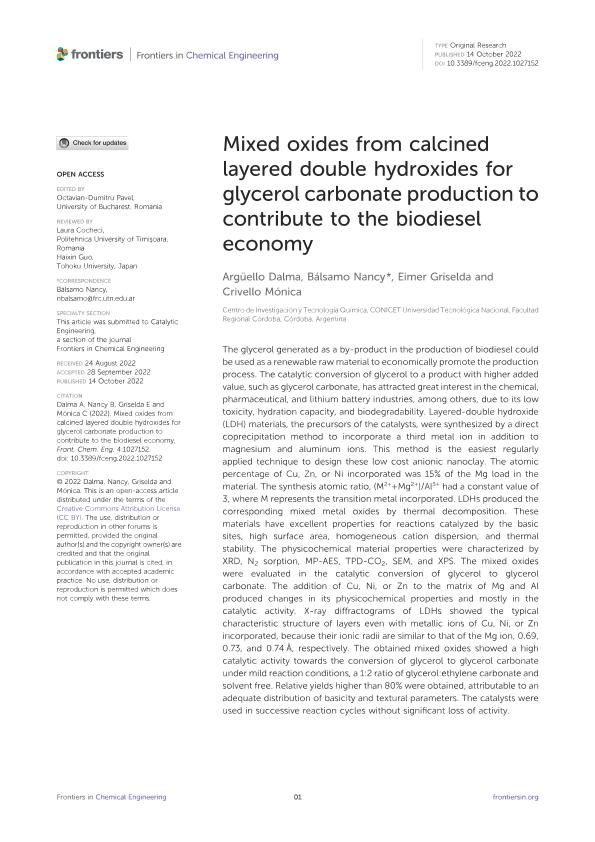Artículo
Mixed oxides from calcined layered double hydroxides for glycerol carbonate production to contribute to the biodiesel economy
Argüello, Dalma Sofía ; Balsamo, Nancy Florentina; Eimer, Griselda Alejandra
; Balsamo, Nancy Florentina; Eimer, Griselda Alejandra ; Crivello, Mónica Elsie
; Crivello, Mónica Elsie
 ; Balsamo, Nancy Florentina; Eimer, Griselda Alejandra
; Balsamo, Nancy Florentina; Eimer, Griselda Alejandra ; Crivello, Mónica Elsie
; Crivello, Mónica Elsie
Fecha de publicación:
14/10/2022
Editorial:
Frontiers Media
Revista:
Frontiers in Chemical Engineering
ISSN:
2673-2718
Idioma:
Inglés
Tipo de recurso:
Artículo publicado
Clasificación temática:
Resumen
The glycerol generated as a by-product in the production of biodiesel could be used as a renewable rawmaterial to economically promote the production process. The catalytic conversion of glycerol to a product with higher added value, such as glycerol carbonate, has attracted great interest in the chemical, pharmaceutical, and lithium battery industries, among others, due to its low toxicity, hydration capacity, and biodegradability. Layered-double hydroxide (LDH) materials, the precursors of the catalysts, were synthesized by a direct coprecipitation method to incorporate a third metal ion in addition to magnesium and aluminum ions. This method is the easiest regularly applied technique to design these low cost anionic nanoclay. The atomic percentage of Cu, Zn, or Ni incorporated was 15% of the Mg load in the material. The synthesis atomic ratio, (M2++Mg2+)/Al3+ had a constant value of 3, where M represents the transition metal incorporated. LDHs produced the corresponding mixed metal oxides by thermal decomposition. These materials have excellent properties for reactions catalyzed by the basic sites, high surface area, homogeneous cation dispersion, and thermal stability. The physicochemical material properties were characterized byXRD, N2 sorption, MP-AES, TPD-CO2, SEM, and XPS. The mixed oxides were evaluated in the catalytic conversion of glycerol to glycerol carbonate. The addition of Cu, Ni, or Zn to the matrix of Mg and Al produced changes in its physicochemical properties and mostly in the catalytic activity. X-ray diffractograms of LDHs showed the typical characteristic structure of layers even with metallic ions of Cu, Ni, or Zn incorporated, because their ionic radii are similar to that of the Mg ion, 0.69, 0.73, and 0.74 Å, respectively. The obtained mixed oxides showed a high catalytic activity towards the conversion of glycerol to glycerol carbonate under mild reaction conditions, a 1:2 ratio of glycerol:ethylene carbonate and solvent free. Relative yields higher than 80% were obtained, attributable to an adequate distribution of basicity and textural parameters. The catalysts wereused in successive reaction cycles without significant loss of activity.
Archivos asociados
Licencia
Identificadores
Colecciones
Articulos(CITEQ)
Articulos de CENTRO DE INVESTIGACION Y TECNOLOGIA QUIMICA
Articulos de CENTRO DE INVESTIGACION Y TECNOLOGIA QUIMICA
Citación
Argüello, Dalma Sofía; Balsamo, Nancy Florentina; Eimer, Griselda Alejandra; Crivello, Mónica Elsie; Mixed oxides from calcined layered double hydroxides for glycerol carbonate production to contribute to the biodiesel economy; Frontiers Media; Frontiers in Chemical Engineering; 4; 1027152; 14-10-2022; 1-10
Compartir
Altmétricas



